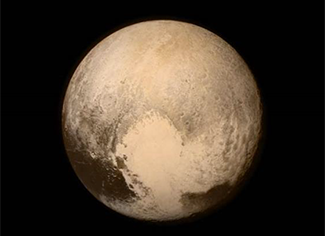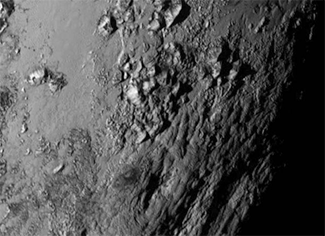Aerospace Micro-Lesson #81
In This Section
Pluto
First observed in 1930, Pluto for a long time was considered to be the farthest object from the Sun in the Solar System. On its discovery, since it was neither an asteroid nor a comet, it was considered to be a planet like the other eight planets. In 1978 it was found to have a moon, as many planets do. As time passed and telescopes got better, more objects were discovered “out in the boondocks” of the Solar System. Pluto was found to be neither the farthest nor even the largest of these objects. In 2006, the International Astronomical Union rearranged the definitions of their words that describe objects in the Solar System, re-categorizing Pluto as a “dwarf planet.” A few years later, the New Horizons spacecraft flew past Pluto, giving us a detailed, close-up look at it and its moons. This lesson describes some of what we know about Pluto.
Next Generation Science Standards (NGSS):
- Disciplinary: Earth and Space Sciences
- Crosscutting Concept: Patterns
- Science & Engineering Practice: Developing and Using Models
GRADES K–2
1-ESS1-1. Use observations of the sun, moon, and stars to describe patterns that can be predicted.
If you go outside at night and look up into the dark sky, you will see stars. If you look in the right place at the right time—toward the south-southwest in the evening to see Mars or toward the south-southeast just before dawn to see Jupiter and Saturn—you will see things that look like bright stars but are not stars. These are planets, things that are made up of rock and gas that go around the Sun as the Earth does. If you take a pair of binoculars and look at the night sky, you can see more things. Faint stars look brighter, stars that were too faint to see without the binoculars are now visible, and the planets may (depending on the planet and the binoculars) look like tiny disks.
As astronomers looked into the night sky with bigger and bigger telescopes, they were able to see things that they could not see with their unaided eyes. They discovered two more planets, like Jupiter and Saturn but farther from the Sun and smaller, and they discovered a lot of smaller objects that they called “asteroids.” (They are still discovering asteroids as well as other objects, by the way. The process of discovery has not stopped.) In 1930, a young astronomer named Clyde Tombaugh discovered something out at the edge of the Solar System. The astronomers declared it a ninth planet and named it Pluto.
Early in the Space Age, starting in the 1960s, people started launching rockets into space to go visit the planets. By the end of 1980, spacecraft had flown past all the planets that you can see without binoculars. Ten years later spacecraft had also flown past the two other planets that astronomers had discovered with telescopes. The next logical step was to send a spacecraft past Pluto to take pictures of it, as had been done with the larger planets. The New Horizons mission studied Pluto and its moons over the summer of 2015.
Astronomers decided to reclassify Pluto as a dwarf planet in 2006 because its orbit passes near that of the planet Neptune. (In fact, between February 1979 and February 1999, Pluto was closer to the Sun than Neptune was). Even so, it remains a part of our solar system and an object of curiosity and scientific investigation, in spite of disparaging remarks such as that from the 1970s television comedy “Mork and Mindy” (Mork, an alien from the fictitious planet Ork, said, “Don’t ever go to Pluto. It’s a Mickey Mouse planet.”)
Students often ask why Pluto was named for Mickey Mouse’s dog, so a brief discussion of the origins of planetary names might be helpful. (In fact, the dog was named after the planet.) They were given names of ancient Roman gods. The name “Pluto” was suggested by Venetia Burney, an eleven-year-old English girl in response to a naming contest put out by Pluto’s discoverers. Some of the names are familiar due to interest in the Percy Jackson books by Rick Riordan, but others do not have that sort of recognition.
Recommended books:
13 planets: : The latest view of the Solar System by David Aguilar
When is a planet not a planet?: The story of Pluto by Elaine Scott
The sun is kind of a big deal by Nick Seluk (cartoon illustrations show the solar system and Pluto keeps making comments such as, “I’m still here, guys!”)
Earth! My First 4.54 Billion Years by Stacy McAnulty (written as an autobiography, Earth explains that is has 7 siblings. “Some used to say I have eight siblings, but Pluto is more like the family pet.”)
GRADES 3–5
In the ninety years since Pluto’s discovery, astronomers have photographed it with ever larger telescopes. The pictures have had ever greater magnifications and greater clarity. It is interesting to follow the evolution of the pictures of Pluto as our means of looking at it have gotten better.
The first photographs of Pluto—at least in which it was recognized—were taken by Clyde Tombaugh in 1930. In these photographs, it is an unassuming dot of light—and nowhere near the brightest such dot in the picture.
In 1978, an astronomer named James Christy discovered Pluto’s moon Charon by noticing that some images of Pluto looked elongated. The bump on the side of the planet moved to the other side of the planet every three days or so, indicating that a moon was circling the planet every six or seven days. The pictures were indistinct enough that the two bodies—Pluto and Charon—did not even look separate from each other; they looked like one oblong blob.
With the launch of the Hubble Space Telescope, the ability to see astronomical objects took another quantum leap. When the Hubble Telescope was trained on Pluto, astronomers were able to distinguish light and dark patches on its disk:
The final improvement—so far—in our viewing of Pluto was provided by the New Horizons spacecraft as it flew past it in 2015. Finally, for the first time, people were able to see details on its surface: hills, plains, mountains, valleys, and other landforms. They took full advantage of this chance and got very detailed pictures.
 |
 |
But the pictures are only of one side: as the spacecraft flew past, one side of the planet was facing away from the Sun and was shrouded in darkness. It will be a long, long time before we can see the other side of Pluto in as much detail as we have seen the side that we know.
GRADES 6–8
MS-ESS1-3. Analyze and interpret data to determine scale properties of objects in the solar system.
The story of the discovery of Pluto begins a century and a half before the actual event, with the discovery of the planet Uranus in 1781. As astronomers observed Uranus over the next few years, they figured out its orbit around the Sun. Newton’s Laws of Motion and of gravitation describe the motions of heavenly bodies very precisely and allowed the astronomers to predict Uranus’ motion well into the future.
As the years turned into decades, though, Uranus did not follow its predicted path; before 1822 it moved faster than expected while after 1822 it moved more slowly than expected. Astronomers theorized that there might be another planet beyond Uranus whose gravity was affecting it. In 1845 two mathematicians, John Couch Adams of England and Urbain Jean Joseph Le Verrier of France, independently made detailed calculations from Uranus’ deviations from its predicted orbit and figured out where this new planet should be. Le Verrier sent his prediction to Johann Galle, a German astronomer, who searched for the new planet and found it within a degree of where Le Verrier said it should be. (As it transpired, they were lucky; at other places in its orbit the planet would not have influenced Uranus enough to be detected.) The new planet was named Neptune.
As astronomers observed Neptune’s motion around the Sun, they calculated an orbit for it. Because Neptune is farther from the Sun than Uranus and moves more slowly, it took much longer for the astronomers to accumulate the data they needed for their calculations. An American astronomer named Percival Lowell examined the deviations of Neptune from its predicted position and calculated where a ninth planet should be. He had built an observatory in Arizona to study the planet Mars and also used the telescope there to search for his predicted planet. He died in 1916 without finding it; after a delay, people at the Lowell Observatory in Arizona assigned the job of resuming the search to a young man named Clyde Tombaugh.
Tombaugh’s method of searching for the new planet was to take a photograph of a likely region of the sky, one small part at a time, wait several days, and then take another photograph of the same region of the sky. He then used a device called a “blink comparator” to look at each pair of photographs, switching between them very quickly. The fixed stars would remain fixed on the photographs while anything that orbits the Sun would have moved during the time between the two photographs and would appear to “jump.” It was tedious but effective.
Young Clyde Tombaugh set to work, photographing the part of the sky where the astronomers had predicted the unknown planet would be and studying the photographs. There was nothing there that resembled a new planet. He expanded the region of his search. After some months of searching, he found a point of light that moved between one photograph and another and that did not correspond to any known object. Tombaugh had found his planet. It was February 18, 1930; after observing it for another few weeks to confirm it, the Lowell Observatory announced the discovery on March 13.
Almost as soon as Pluto was discovered, astronomers realized that it could not be responsible for perturbing Neptune with its gravity as Neptune perturbed Uranus. For starters, it was in the wrong part of the sky. For another thing, it was not big enough. Astronomers could calculate how far it was from the Sun and could measure directly how bright it appears to be. With a decent guess for how reflective it is (using Venus as very reflective, Jupiter as typical, and Mercury or the Moon as not so reflective), they could estimate how large it would have to be in order to appear as bright as it does. And Pluto was far too small to have enough gravity to affect Neptune’s position. Eventually another astronomer examined Percival Lowell’s calculations and found an error; Lowell had been mistaken in his prediction.
After discovering Pluto, Tombaugh continued his search for another planet. Eventually he searched the entire Ecliptic—the part of the sky in which the planets move—and found nothing. There are (and were) other things out there but they were too small and too far from the Sun for him to see them.
GRADES 9–12
The decision by the International Astronomical Union in 2006 to “demote” Pluto from planet status to being merely a “dwarf planet” caused a great deal of controversy, both in the astronomical community and among the public at large. Indeed, the controversy has not completely gone away, even a decade after the decision. Something to note, however, is that all the controversy on Earth about Pluto’s status has had absolutely no effect on Pluto itself. Pluto was placidly circling the Sun long before people first saw it and will continue to do so well into the foreseeable future.
We sort things into categories to make it easier for us to discuss them. It is much easier, for example, to speak of birds as a class than it is to enumerate every single type of bird. Again, it is easier to speak of pigeons as a class than it is to list every single pigeon in the world. All things that are true of birds in general are also true of pigeons; all things that are true of pigeons in general also hold for each individual pigeon.
In the same way, we speak of planets as a class. As more and more objects were being discovered beyond Pluto, the question arose of whether to call them planets, asteroids, comets, plutoids, KBOs (Kuiper Belt Objects), or something else. The definition of a word is something that people agree upon so that they can communicate with each other and understand each other; it does not affect the thing being defined. A word’s definition is not right or wrong. It may be good in that it is simple, clear, objective, and widely applicable, or it may be bad in that it is complex, confusing, subjective, or narrow. All that is really necessary, though, is that it be agreed upon by the people who are using the word.
Pluto was discovered as a result of a search because its gravity was supposedly affecting the motion of Neptune in its orbit. As the twentieth century progressed, though, estimates of Pluto’s size and mass (and therefore gravitational attraction) kept getting smaller and smaller. Finally in 1978, with the discovery of a moon orbiting Pluto, scientists were able to calculate the mass accurately. (The moon was named Charon, a name associated with Pluto in Greek mythology and also resembling the name of the discoverer’s wife. It is pronounced “Sharon” with a soft “Ch.”) They can calculate the mass because the period of an orbit depends only on the orbit’s radius and the masses of the bodies involved. (The gravitational influence of Pluto on Neptune depends only on the sum of the masses involved.) Newton’s Law of Gravitation states that the gravitational force between two bodies is proportional to the product of their masses and inversely proportional to the distance between their centers:

In this equation:
- F is the gravitational force between the two bodies
- G is the gravitational constant,
- M is the mass of the body being orbited, Pluto in this case
- m is the mass of the orbiting body, in this case Charon
- D is the distance between the centers of the two bodies
The equation for the centripetal force on an object that is moving in a circle is

In this equation:
- F is the centripetal force acting on the orbiting body
- m is the mass of the orbiting body
- V is the speed of the orbiting body
- R is the radius of the circle in which the body is moving, in this case the radius of the orbit
- W is the angular velocity of the orbiting body
The angular velocity deserves some attention. It is the rate at which something that is moving in a circle moves around the center of that circle. It is usually measured in radians per second or degrees per second. While your students should be familiar with degrees,p radians in a whole circle because the circumference of a circle is 2p r. One radian is about equal to 57.3 degrees. And the amount of time “T” that a body takes to go around a circle is 2p divided by the angular velocity:

Finally, the radius of the smaller body’s orbit is proportional to the distance between the bodies and the ratio of the other body’s mass to the total mass:

Equating the gravitational force and the centripetal force and putting these equations all together gives

Several factors cancel each other out and we get the sum of the masses of Pluto and Charon:

Measuring the orbital period of Charon was quite simple; measuring the distance between Pluto and Charon, while more difficult, was easier than measuring Pluto’s diameter and guessing at is density. Thanks to more and more accurate measurements, we now know with great precision that Pluto’s mass is 2.886×1022 pounds (1.309×1022 Kg), or 0.0025 times that of the Earth.
It turns out that Charon is so large and massive relative to Pluto that Pluto and Charon both orbit around a center of mass (called a “barycenter”) between them. They form a “double planet” system, the only one in the Solar System—that we know of. They are also tidally locked with each other, as the Moon is with the Earth (although the Earth is not tidally locked with the Moon). The same side of Pluto always faces Charon and the same side of Charon always faces Pluto. A person standing on one body would always see the other in about the same part of the sky, or would not see it at all. The other body would seem to move slightly in the sky because Pluto and Charon do not orbit each other in a perfect circle but the rotation rate is constant; the effect is similar to the Moon’s librations.
Interestingly, the four other moons in the Pluto-Charon system seem not to have a constant rotation rate or direction. They are so small that they are quite elliptical and their orbits take them sometimes closer to Pluto and other times closer to Charon, so that the gravitational pull on the elliptical bulges varies. This has been observed with two of the moons and is probably also true for the other two.
Sixty Years Ago in the Space Race:
March 1, 1959: The United States Air Force and NASA announced the solid-fueled Scout rocket which could deliver small payloads to orbit. It was dubbed the "poor man's rocket."
March 3, 1959: The American Pioneer 4 spacecraft was launched toward the Moon but missed and went into orbit around the Sun, becoming the second artificial object to do so.



